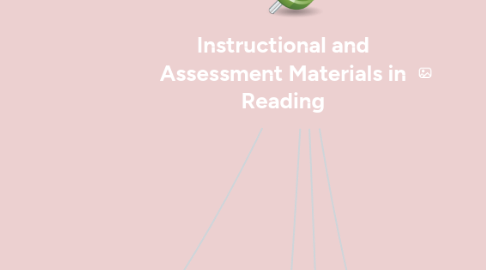
1. Principle 5: Balance humanistic and technological practices.
1.1. Humanistic Strategies
1.1.1. Instructional materials and activities prepared by the teacher.
1.1.1.1. Print media
1.1.1.2. Graphics
1.2. Technological practices
1.2.1. Audio-visual equipment. Integrating technology to instruction.
1.2.1.1. Film clips
1.2.1.2. Slides
1.2.1.3. Video tapes
1.2.1.4. Taped recordings
1.2.1.5. Movies
1.2.1.6. Computer-assisted instruction
2. Functions of Instructional Materials
2.1. to enlist prior knowledge
2.2. to motivate the learners
2.3. to introduce a new lesson
2.4. to sustain learners' interest
2.5. to make learning pleasurable
2.6. to link up past lesson with new
2.7. to review past lesson
2.8. to concretize abstract concepts
2.9. to clarify or enrich concepts
2.10. to unlock vocabulary
2.11. to provide models/examples
2.12. to organize thinking
2.13. to give directions/guidelines
2.14. to provide background information
2.15. to monitor learning
2.16. to assess learning
2.17. to evaluate performance
2.18. to sustain learners' interest
3. The five E's that an instructional material should have.
3.1. effective
3.2. efficient
3.3. economical
3.4. engaging
3.5. enjoyable
4. Principles of Instructional Materials Design
4.1. Principle 1: Develop units around themes.
4.1.1. Instruction is organized around themes and topics.
4.1.1.1. Theme
4.1.1.1.1. It is a declarative statement of a point of view or perspective.
4.1.1.2. Topic
4.1.1.2.1. It is the subject matter.
4.2. Principle 2: Structure and sequence content into meaningful contexts.
4.2.1. It is composed of the major ideas and insights that the students need to understand and gain from the lesson.
4.2.2. A graphic organizer could be used when listing the possible topics and ideas. It is a tool or framework that can be used in presenting information visually.
4.2.2.1. Semantic web
4.2.2.2. KWL Chart
4.2.2.3. Spider Map
4.2.2.4. Venn Diagram
4.2.2.5. Concept Map
4.3. Rowntree cite some ways of sequencing the content.
4.3.1. Random Topics
4.3.1.1. The topics are independent. It would not matter how they are sequenced.
4.3.2. Chronological
4.3.2.1. The topics are discussed in order they happen by following some kind of time order.
4.3.3. Structural Logic
4.3.3.1. The students' knowledge of a topic is a prerequisite in understanding a subsequent topic.
4.4. During reading
4.4.1. Pre-reading
4.5. Principle 3: Use interactive teaching strategies and activities.
4.5.1. Post-reading
4.6. Principle 4: Use informal process-oriented assessment strategies.
4.6.1. Assessments include more informal approaches less reliance on formal conventional tests.
4.6.2. Student-centered
4.6.3. Test scores at times misrepresenting individuals progress in learning.
5. Procedures in Materials Development
5.1. Stages of Materials Development
5.1.1. Planning
5.1.1.1. Deciding on the unit theme.
5.1.1.1.1. Formulate the unit goals and specific objectives.
5.1.2. Development
5.1.2.1. Production phase
5.1.2.1.1. Choosing the materials.
5.1.3. Field Tryout
5.1.3.1. The instructional materials go through the potential users.
5.1.3.2. It is needed to determine the following:
5.1.3.2.1. Time needed to finish the material.
5.1.3.2.2. Sustainability of learner's involvement and interest.
5.1.3.2.3. Assess the difficulty of the selections used.
5.1.4. Evaluation
5.1.4.1. Done by the teachers handling the same grade level you are working on.
5.1.5. Revision/Finalization
5.1.5.1. Suggest some changes, deletions, insertions, or expansions to improve the materials.
5.2. Models of Materials Development
5.2.1. The ASSURE Model
5.2.1.1. Analyze your learner
5.2.1.1.1. State your objectives
5.2.2. The HOPKIN Model
5.2.2.1. Belief Statements
5.2.2.1.1. Specific Objectives
6. Classification of Instructional Materials
6.1. Edgar Dale
6.1.1. Cone of Experience
6.1.1.1. Verbal Symbols
6.1.1.2. Visual Symbols
6.1.1.3. Recording, Radio, Still Pictures
6.1.1.4. Motion Pictures
6.1.1.5. Educational Television
6.1.1.6. Exhibits
6.1.1.7. Study Trips
6.1.1.8. Demonstrations
6.1.1.9. Dramatized Experience
6.1.1.10. Contrived Experience
6.1.1.11. Direct, Purposeful Experience
6.2. Robert Heinich
6.2.1. Non-projected Materials
6.2.1.1. Real Objects
6.2.1.2. Models, Globe
6.2.1.3. Printed Materials
6.2.1.3.1. textbooks
6.2.1.3.2. workbooks
6.2.1.3.3. exercises
6.2.1.3.4. handouts
6.2.1.3.5. charts
6.2.1.3.6. graphs
6.2.1.3.7. organizers
6.2.1.3.8. test materials
6.2.1.4. Illustrated materials
6.2.1.4.1. diagrams
6.2.1.4.2. sketches
6.2.1.4.3. maps
6.2.1.4.4. pictures
6.2.1.4.5. photographs
6.2.1.4.6. cartoons
6.2.1.4.7. caricatures
6.2.1.5. Display materials
6.2.1.5.1. flat display
6.2.1.5.2. 3-dimensional display
6.2.1.6. Movable materials
6.2.1.6.1. flannel boarrd
6.2.1.6.2. magnetic board
6.2.1.6.3. puppets, marionettes
6.2.1.6.4. mobiles
6.2.1.6.5. roll-up theater
6.2.2. Projected Materials
6.2.2.1. overhead projector/transparencies
6.2.2.2. opaque projector
6.2.2.3. slide projector/slides
6.2.3. Audio-assisted Materials
6.2.3.1. radio
6.2.3.2. cassette recorder/cassette tapes
6.2.3.3. laser disk player/LDs and CDs
6.2.4. Video and Films
6.2.4.1. VHS/video tapes
6.2.4.2. Filmstrips/movies
6.2.5. Computer-Assisted Materials
6.2.5.1. Computer-assisted lessons
6.2.5.2. Computer-projected materials

